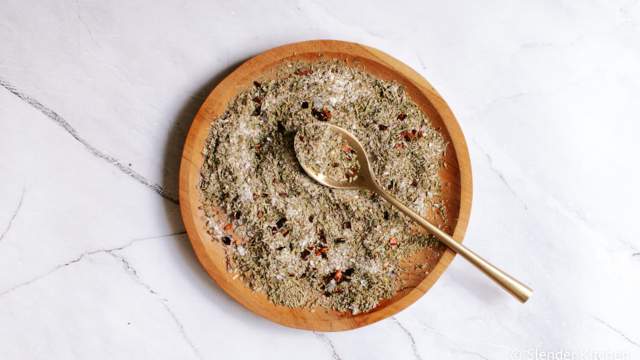
Homemade Italian Seasoning that can be used in so many different dishes from pasta to soups to grilled meats and roasted vegetables. This homemade spice blend with dried herbs, garlic powder, and red pepper flakes is a pantry staple.
When it comes to a powerhouse spice blend that you can use for almost anything, Italian spice blends are it. With its combination of dried herbs, garlic, and a hint of spice, this seasoning blend adds so much flavor to dishes without the need to measure out all different herbs and spices.
Last week, I was talking to a friend who was stocking her spice cabinet for the first time and she wanted to know what I find myself using the most. At the top of that list was Italian seasoning. Whenever I need to add quick flavor to something, that's the spice blend I reach for. It has everything you need, packaged in one easy to use jar.
However, like most things, I like to make my own Italian seasoning at home so I can control the ingredients. Not only can I choose the herbs and quantities, I can also make sure it doesn't have any unnecessary preservatives or sugar. The version I am sharing today is the one I use on a daily basis, but adjust it to fit your personal preferences.
Then start using it! This works to season so many different dishes. Use it to quickly season meats and vegetables. Add it to soups and stews to add a great depth of flavor. Add it to salad dressings and dips. Sprinkle it on pizza and flatbreads, Seriously, this states good on everything.

What is Italian seasoning made of?
There are lots of different recipes out there for this Italian spice blend but the base should always be a blend of dried herbs. From there, some recipes will call for additional dried spices like garlic powder, onion powder, red pepper flakes, or dried Calabrian chili peppers. Most spice blends do not contain salt or pepper but those can be added as well.
- Dried herbs: The base of all Italian spice blends should always be a variety of dried herbs. This usually includes dried oregano, thyme, basil, marjoram, rosemary, and sage. Some mixes may also include dried parsley. The exact combination of these dried herbs and the quantity can vary and can be adjusted to suit your individual tastes.
- Flavor Enhancers: Whether or not Italian seasoning should contain garlic is a bit controversial but personally I believe there can never be enough garlic. You can make a blend with just dried herbs or include garlic powder or dehydrated garlic like is done in this recipe.
- Optional additions: There are lots of other options to round out this homemade Italian seasoning including red pepper flakes, onion powder, salt, and pepper. It all depends on your personal preferences and how you plan to use it.
When making your own spice blend at home, remember that you can always add additional seasoning and spices when you are cooking. For example, if you don't always like spice, then leave the red pepper flakes out of the mix. Then just add them while cooking. The same goes for the garlic powder and other optional ingredients.
Recipe Ideas and Tips
Although a spice blend may not seem like a place to make lots of adjustments, there are actually lots of ways to personalize this spice blend.
- One of the best ways to add flavor to this recipe is to add some dehydrated garlic and onion to the mix. Dehydrated garlic and onion is a bit different than the powder since it has some bite and texture. The flavor really comes through.
- If you like spice, make sure to include the red pepper flakes. Adjust the amount depending on how spicy you like things.
- If you don't like a really strong herbal flavor, leave out a couple of the herbs.
- This Italian seasoning can be made with fewer dried herbs if you don't have everything on hand. For example, many people find they don't have marjoram and it's not an herb they use often. Just leave it out.
Recipes Using Italian Seasoning
There are so many uses for this Italian spice blend, it can be hard to know where to start. Here are some easy recipe ideas as well as some build your own recipes using this yummy seasoning blend.
- Make delicious roasted, sauteed, or grilled vegetables by tossing chopped vegetables with olive oil, the spice blend, salt, and pepper. They will be packed with flavor from all the different dried herbs.
- Use this to marinate chicken or pork with a combination of olive oil, Italian spices, lemon juice, and red wine vinegar. Throw this on the grill for an easy meal.
- Combine Italian seasoning with kosher salt, lemon zest, and a small amount of oil to create a wet rub for grilled protein and seafood.
- Use this to season pasta and pasta sauces.
- Make your own homemade ground sausage using turkey, beef, or pork, and this spice blend.
- Try this easy Sheet Pan Italian Chicken and Vegetables that use Italian seasoning as the many flavor builder.
- Use Italian seasoning to build flavors in slow cooker dishes like soups, stews, or this Slow Cooker Pepperoncini Beef.

How to Store Homemade Spices
Homemade spice blends should be kept in an airtight container in a dark cool place. Usually, I will save my old spice jars when they are empty and use those to store my homemade mixes. Homemade spice blends last about 6 months.